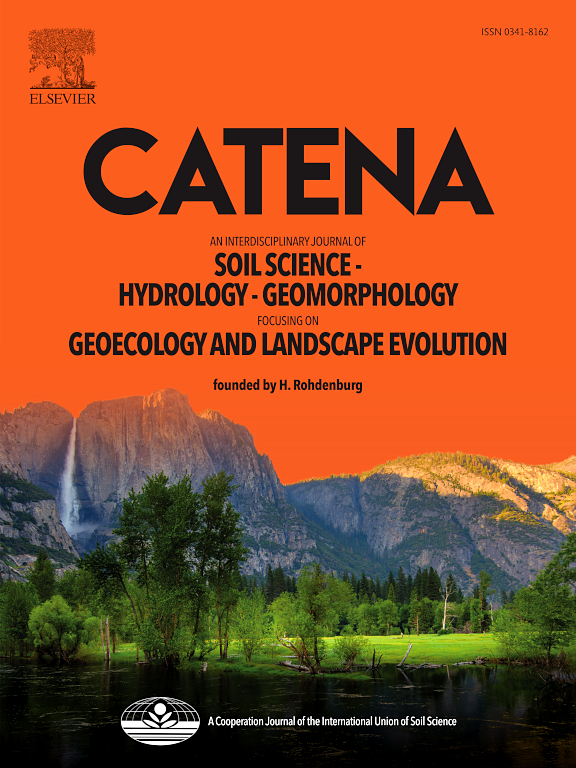连续降雨条件下黄土坡农田不同微地形的水力侵蚀控制机制
IF 5.4
1区 农林科学
Q1 GEOSCIENCES, MULTIDISCIPLINARY
引用次数: 0
摘要
本文章由计算机程序翻译,如有差异,请以英文原文为准。

Mechanisms of hydraulic erosion control in different microrelief patterns of loess sloped farmland under continuous rainfall
Different microrelief patterns of sloped farmland have important effects on soil erosion. However, its hydraulic erosion control mechanism under continuous rainfall is unclear. In this study, the effects of two microrelief patterns (reservoir tillage (RT) and contour tillage (CT)) of sloped farmland on runoff, soil erosion, and hydrodynamic parameters were investigated at the plot scale using simulated rainfall and high-definition photography methods. Smooth slopes (SS) were chosen as a control. The test rainfall intensities (RIs) were selected as 30, 60, 90, and 120 mm h−1. Two continuous rainfall events, each lasting 40 min, were conducted on each type of slope. The results show that the different microrelief patterns have a twofold role in soil erosion on slopes as influenced by rainfall conditions. During the first rainfall, compared to SS, the RT and CT increased the Darcy–Weisbach coefficient and reduced the surface flow velocity. The RT and CT significantly increased the initial runoff time and reduced runoff yield (10.9–69.46 %) and sediment yield (9.87–74.87 %). However, during the second rainfall event, the water-retaining terrain of the RT and CT was destroyed. This resulted in reduced Darcy–Weisbach coefficients and increased flow velocities on the RT and CT. Compared to the SS, the RT reduced the runoff yield (10.59–63.86 %) and sediment yield (19.04–51.17 %) under RIs of 30, 60, and 90mm h−1, but the magnitude of reduction decreased compared to the first rainfall event. The RT increased the runoff yield (11.32 %) and sediment yield (6.08 %) under the RI of 120 mm h−1. The CT increased the runoff yield (19.13–24.88 %) and sediment yield (15.75–46.32 %) under all four RIs. In addition, statistical analysis indicated that stream power could explain 79 % of the changes in runoff and sediment yield on RT and CT, and effective stream power could account for 79 % of the variations in runoff and sediment yield on SS. Stream power served as the optimal indicator for characterizing the runoff and sediment yield rates on RT and CT, whereas effective stream power was the best metric for SS. This study can help us to better explain the mechanism of hydraulic erosion control in different microrelief patterns.
求助全文
通过发布文献求助,成功后即可免费获取论文全文。
去求助
来源期刊

Catena
环境科学-地球科学综合
CiteScore
10.50
自引率
9.70%
发文量
816
审稿时长
54 days
期刊介绍:
Catena publishes papers describing original field and laboratory investigations and reviews on geoecology and landscape evolution with emphasis on interdisciplinary aspects of soil science, hydrology and geomorphology. It aims to disseminate new knowledge and foster better understanding of the physical environment, of evolutionary sequences that have resulted in past and current landscapes, and of the natural processes that are likely to determine the fate of our terrestrial environment.
Papers within any one of the above topics are welcome provided they are of sufficiently wide interest and relevance.
 求助内容:
求助内容: 应助结果提醒方式:
应助结果提醒方式:


